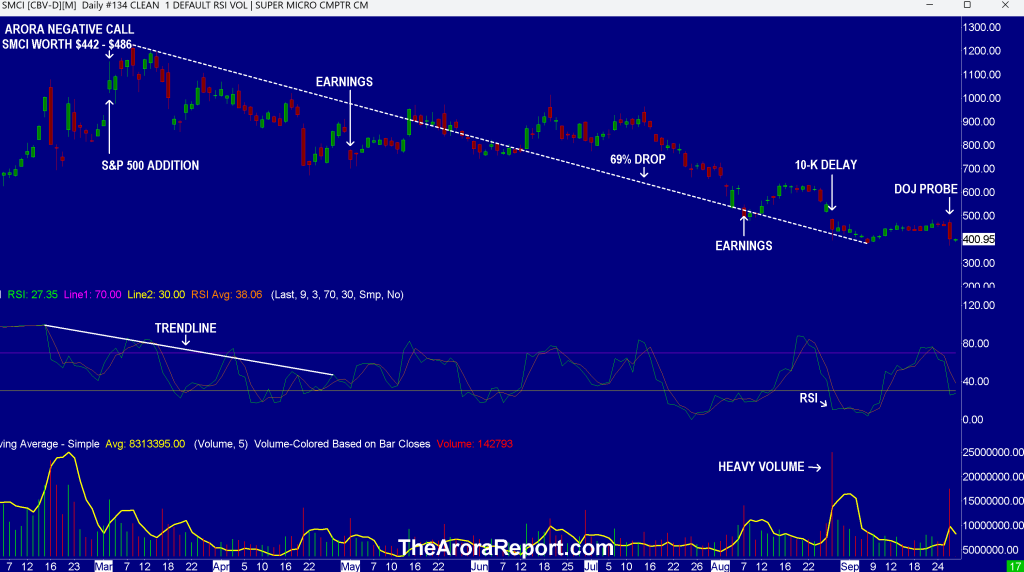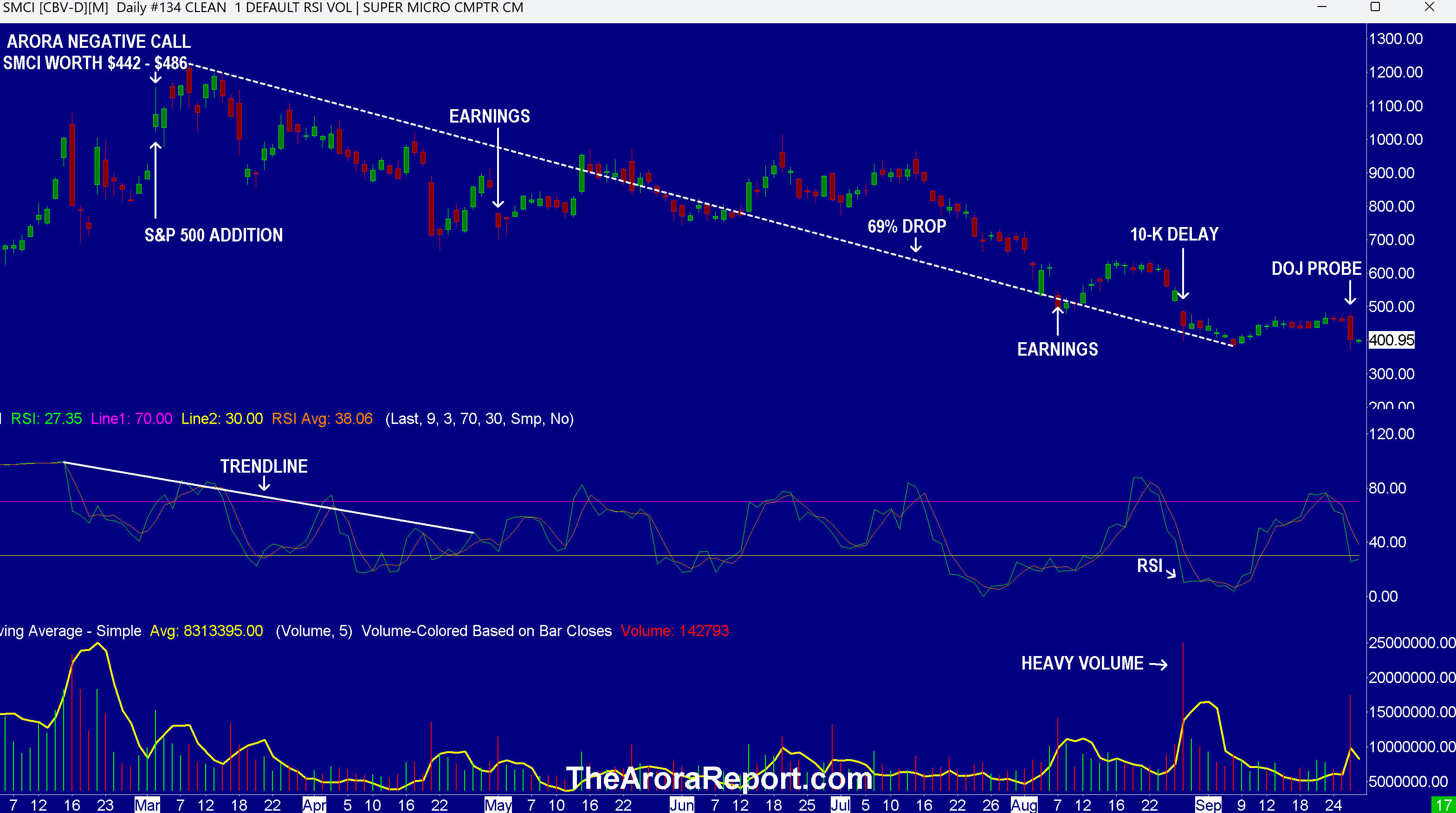
To gain an edge, this is what you need to know today.

Spending Disappointment
Please click here for an enlarged chart of Super Micro Computer Inc SMCI.
Note the following:
- This article is about the big picture, not an individual stock. The chart of SMCI stock is being used to illustrate the point.
- A fortune is to be made in artificial intelligence, but it is not going to be in a straight line. At times, it is going to be treacherous. It is important to not make mistakes by getting carried away with the momo crowd and listening to momo gurus who have a vested interest that is not your best interest.
- The chart shows that momo crowd favorite SMCI fell yesterday on the news of a Department of Justice (DOJ) probe due to allegations of accounting irregularities. A DOJ probe is a serious matter as it is often a criminal probe.
- The chart shows that the enthusiasm was at its peak right after SMCI stock was added to S&P 500.
- The chart shows from the peak to the low, the stock lost 69% of its value.
- The chart shows that the day S&P 500 added SMCI stock, The Arora Report made a bold call. The Arora Report call was that SMCI was worth only $442 – $486 in the best case. The stock peaked at $1229. As of this writing in the premarket, SMCI stock is trading at $400.95. All Arora Report calls are 100% transparent, traceable, and auditable. Members have access to over ten years of archives, including the winners and losers – no cherry picking.
- Right now, the momo crowd is sitting on massive losses in SMCI stock. The momo crowd was not able to distinguish between NVIDIA Corp NVDA and Super Micro Computer – the prevailing belief among the momo crowd was that NVDA and SMCI were the same.
- The U.S. economy is 70% consumer based. For this reason, prudent investors pay attention to personal income and personal spending. Just released personal income and spending data is disappointing. Here are the details of the new personal income and spending data:
- Personal income came at 0.2% vs. 0.4% consensus.
- Personal spending came at 0.2% vs. 0.3% consensus.
- PCE is the Fed’s favorite inflation gauge. Here are the details:
- PCE came at 0.1% vs. 0.1% consensus.
- Core PCE came at 0.1% vs. 0.2% consensus.
- In The Arora Report analysis, the data is in line with expectations. As such, this data should have no impact on the stock market.
- Even though the stock market pays a lot of attention to PCE, in The Arora Report analysis, economists have become really good at projecting PCE. As such, investors’ expectations, in general, should be that PCE will come in line with consensus.
Japan
Bank of Japan (BOJ) actions are very important for U.S. investors. The reason is the carry trade. In carry trade, funds borrow in yen and invest in the U.S. stock market. Lately, they have been buying AI stocks. Japan’s ruling party LDP has chosen Shigeru Ishiba as its new leader. Ishiba is the next prime minister of Japan. In The Arora Report analysis, yen is rallying on the news as Ishiba is a supporter of BOJ.
In The Arora Report analysis, this development is negative for the carry trade and positive for the yen position using ETF Invesco CurrencyShares Japanese Yen Trust FXY in The Arora Report’s ZYX Allocation.
Magnificent Seven Money Flows
In the early trade, money flows are positive in Apple Inc AAPL, Alphabet Inc Class C GOOG, Microsoft Corp MSFT, and Tesla Inc TSLA.
In the early trade, money flows are neutral in Amazon.com, Inc. AMZN, Meta Platforms Inc META, and NVDA.
In the early trade, money flows are positive in SPDR S&P 500 ETF Trust SPY and Invesco QQQ Trust Series 1 QQQ.
Momo Crowd And Smart Money In Stocks
Investors can gain an edge by knowing money flows in SPY and QQQ. Investors can get a bigger edge by knowing when smart money is buying stocks, gold, and oil. The most popular ETF for gold is SPDR Gold Trust GLD. The most popular ETF for silver is iShares Silver Trust SLV. The most popular ETF for oil is United States Oil ETF USO.
Bitcoin
Bitcoin BTC/USD is on track to have the best September ever.
Protection Band And What To Do Now
It is important for investors to look ahead and not in the rearview mirror.
Consider continuing to hold good, very long term, existing positions. Based on individual risk preference, consider a protection band consisting of cash or Treasury bills or short-term tactical trades as well as short to medium term hedges and short term hedges. This is a good way to protect yourself and participate in the upside at the same time.
You can determine your protection bands by adding cash to hedges. The high band of the protection is appropriate for those who are older or conservative. The low band of the protection is appropriate for those who are younger or aggressive. If you do not hedge, the total cash level should be more than stated above but significantly less than cash plus hedges.
A protection band of 0% would be very bullish and would indicate full investment with 0% in cash. A protection band of 100% would be very bearish and would indicate a need for aggressive protection with cash and hedges or aggressive short selling.
It is worth reminding that you cannot take advantage of new upcoming opportunities if you are not holding enough cash. When adjusting hedge levels, consider adjusting partial stop quantities for stock positions (non ETF); consider using wider stops on remaining quantities and also allowing more room for high beta stocks. High beta stocks are the ones that move more than the market.
Traditional 60/40 Portfolio
Probability based risk reward adjusted for inflation does not favor long duration strategic bond allocation at this time.
Those who want to stick to traditional 60% allocation to stocks and 40% to bonds may consider focusing on only high quality bonds and bonds of five year duration or less. Those willing to bring sophistication to their investing may consider using bond ETFs as tactical positions and not strategic positions at this time.
The Arora Report is known for its accurate calls. The Arora Report correctly called the big artificial intelligence rally before anyone else, the new bull market of 2023, the bear market of 2022, new stock market highs right after the virus low in 2020, the virus drop in 2020, the DJIA rally to 30,000 when it was trading at 16,000, the start of a mega bull market in 2009, and the financial crash of 2008. Please click here to sign up for a free forever Generate Wealth Newsletter.
Market News and Data brought to you by Benzinga APIs
© 2024 Benzinga.com. Benzinga does not provide investment advice. All rights reserved.
